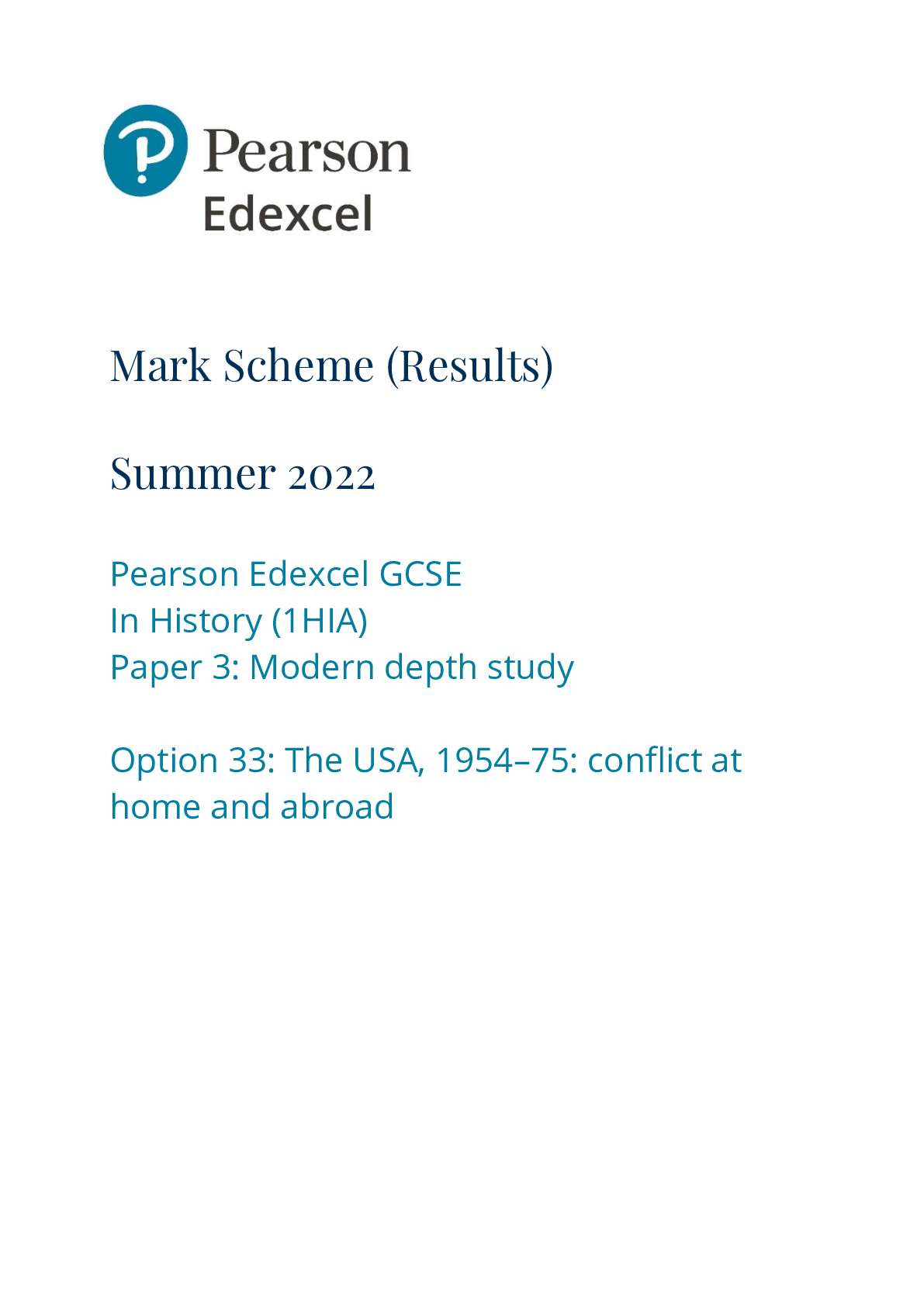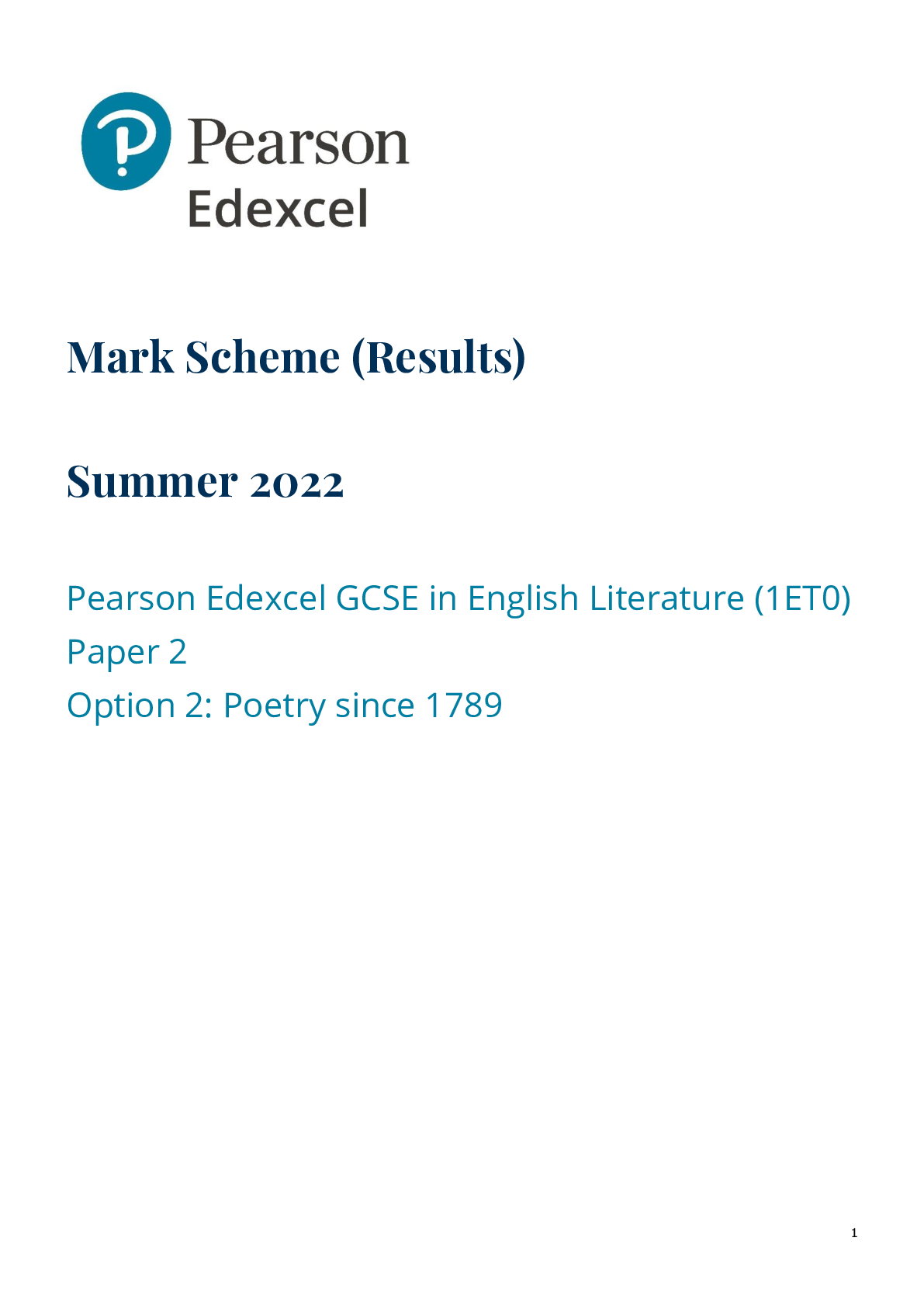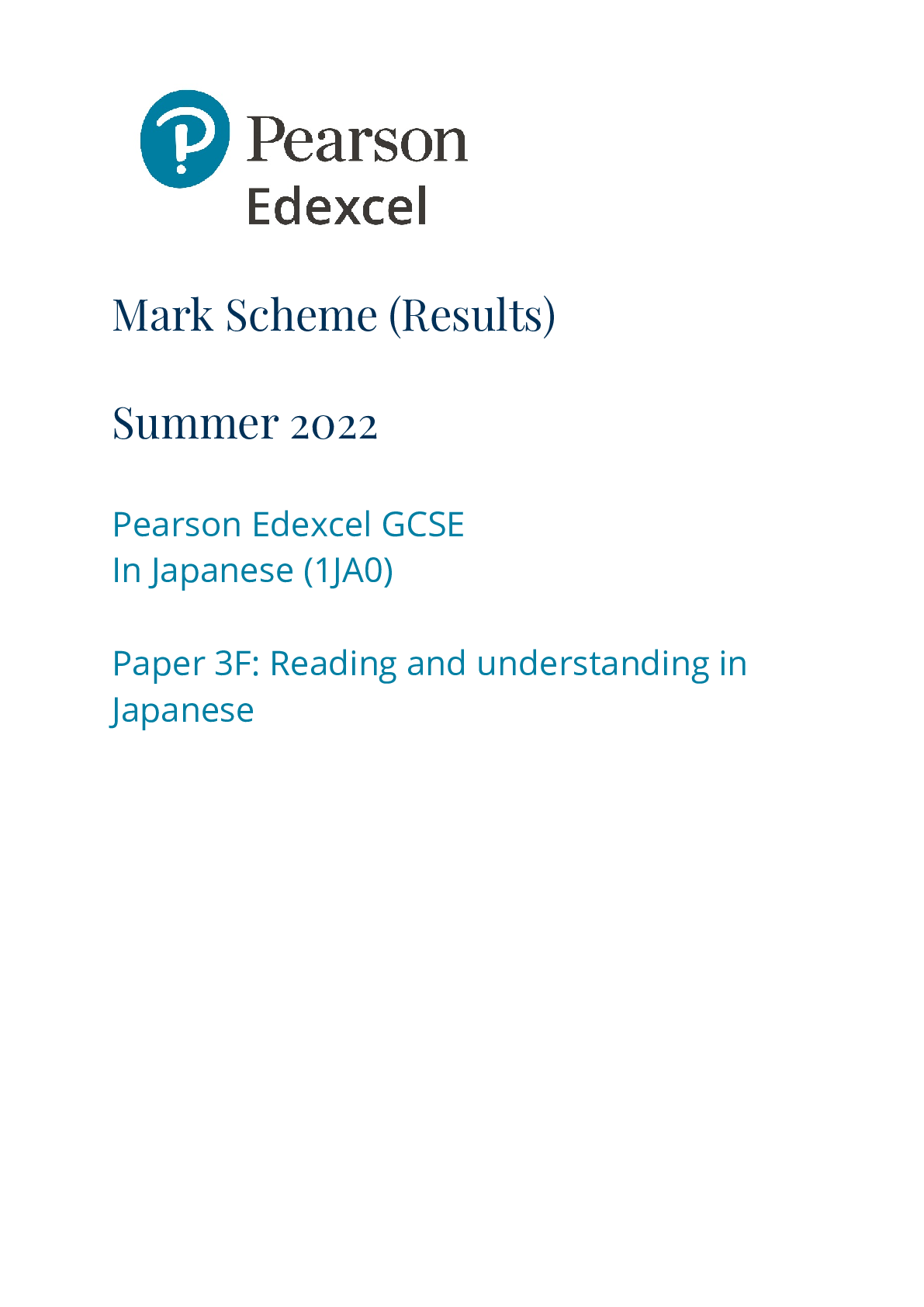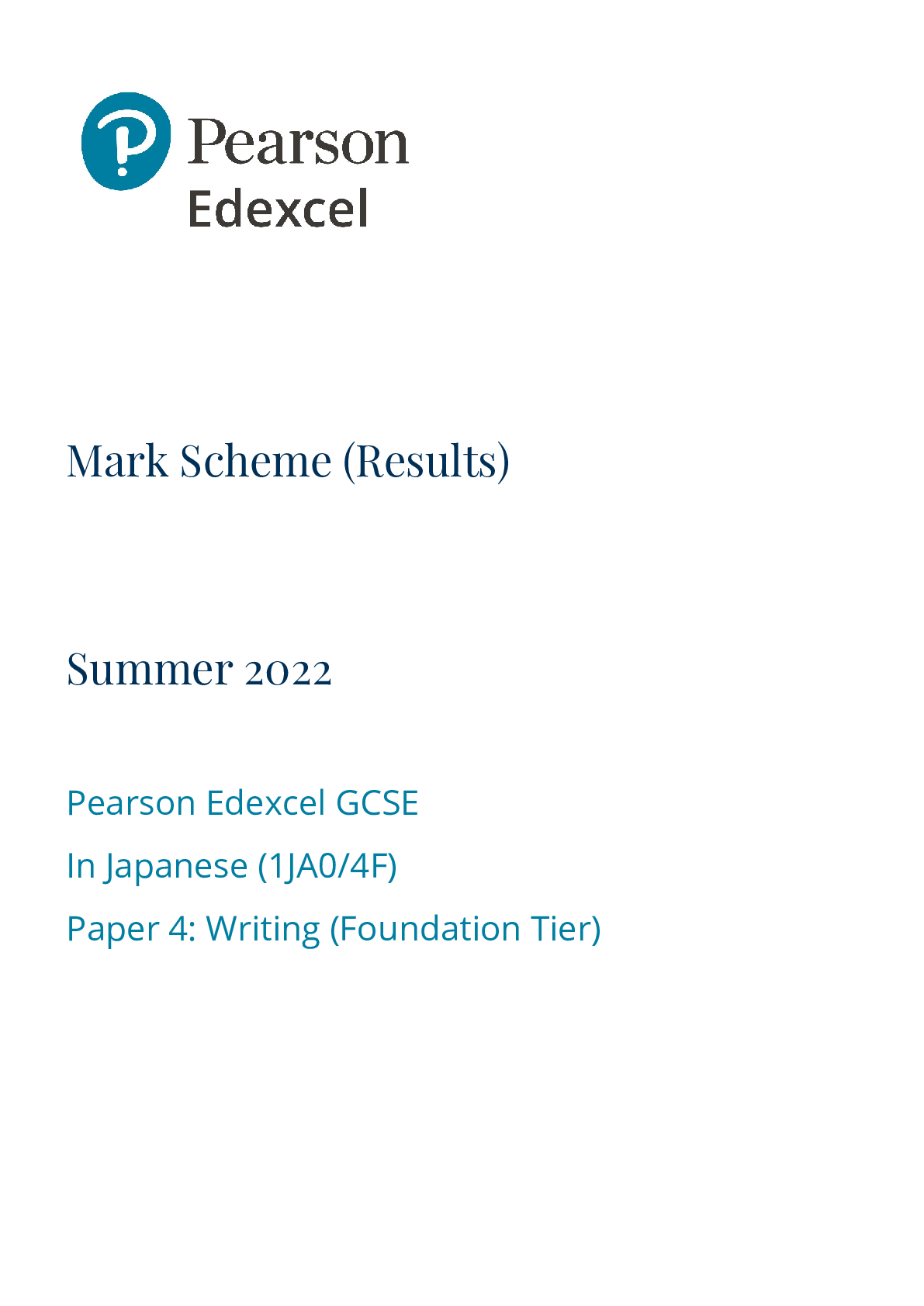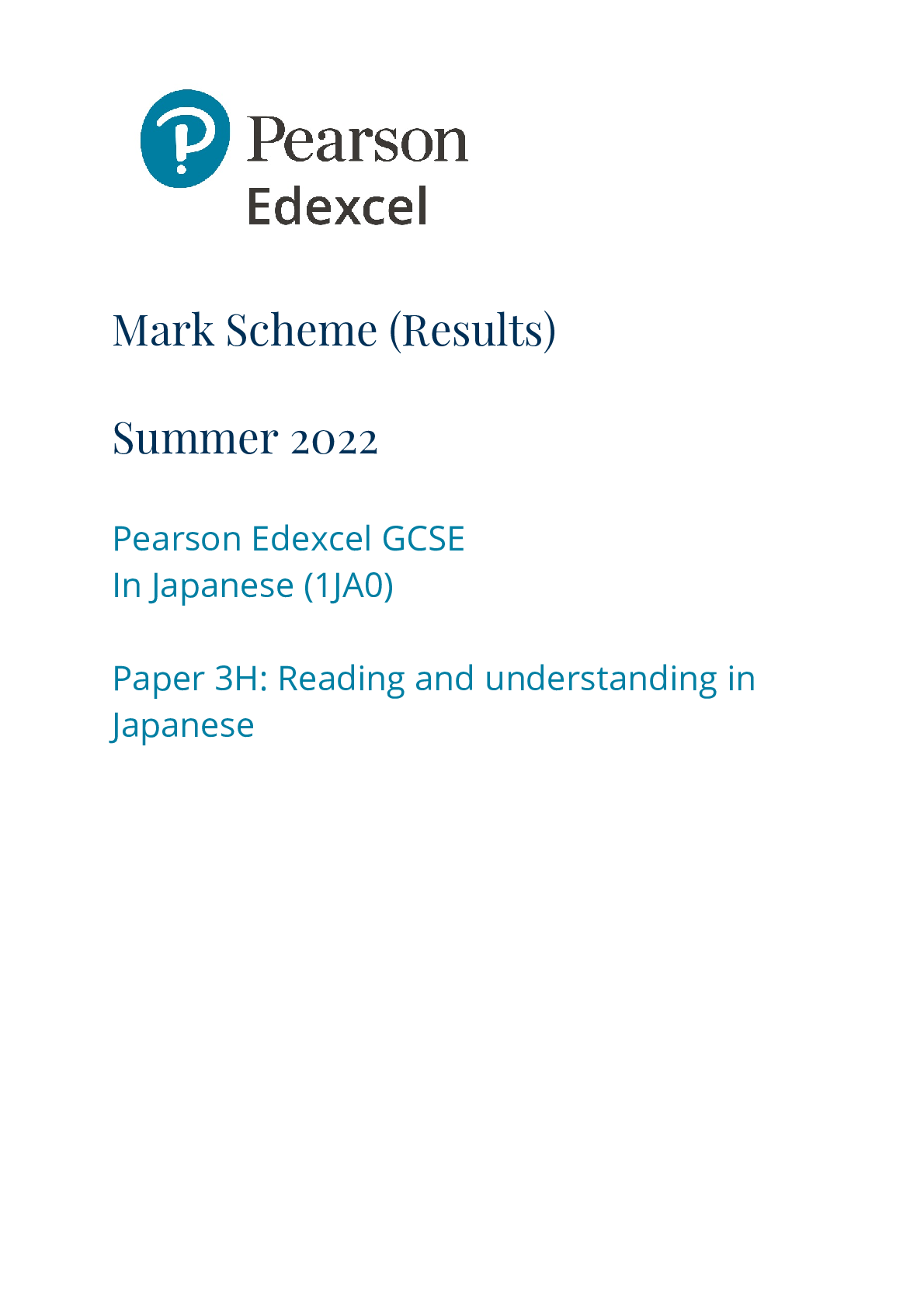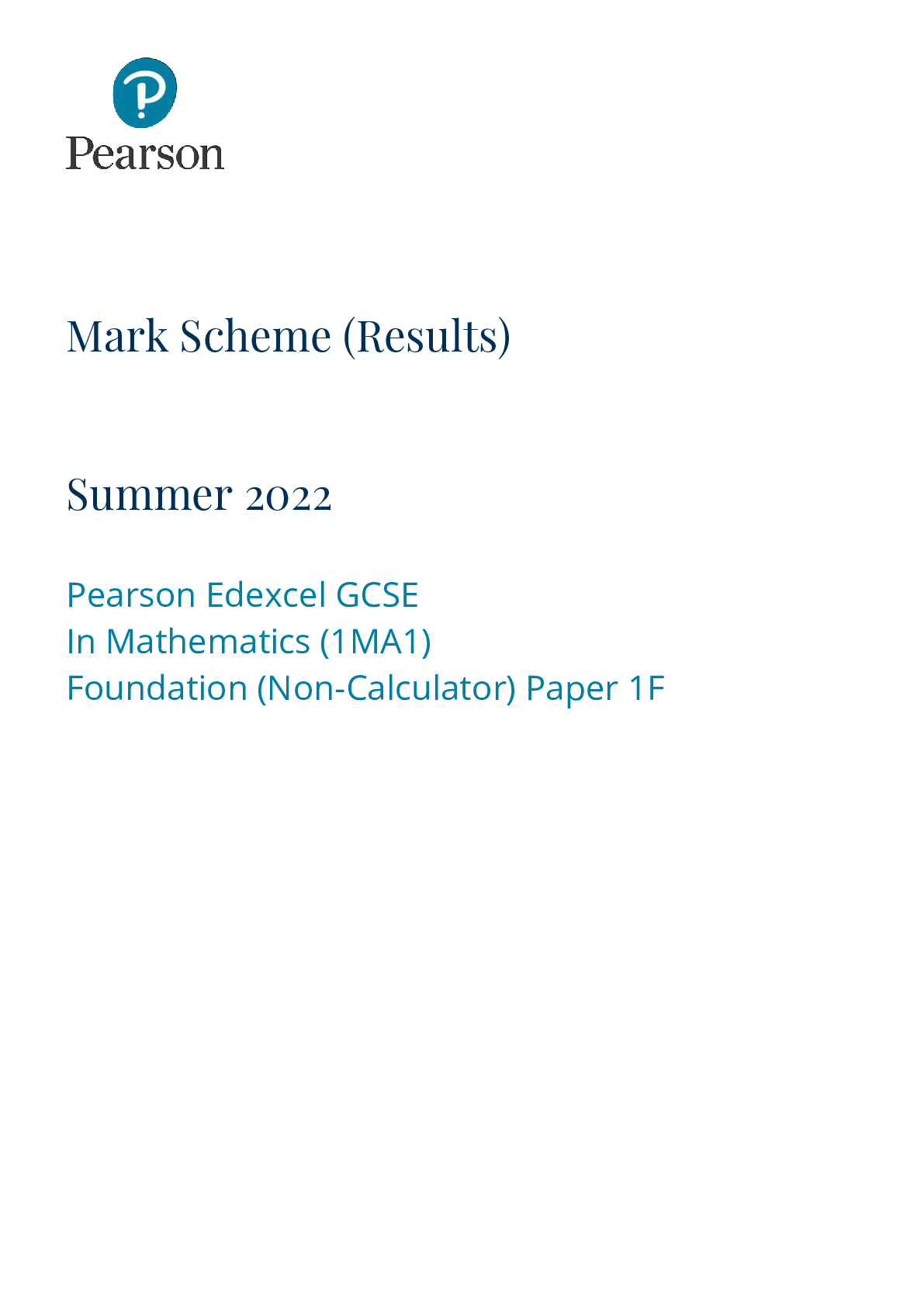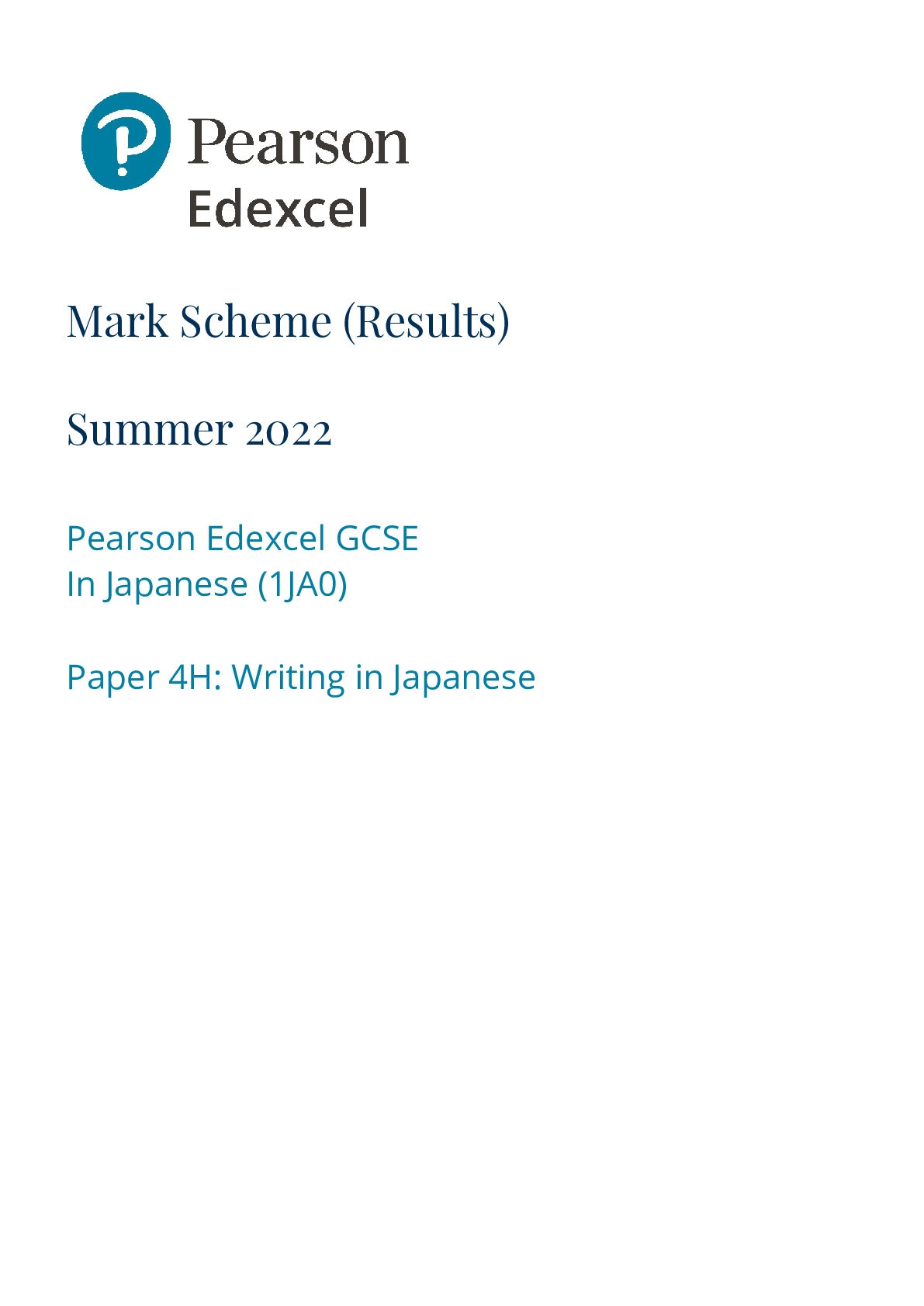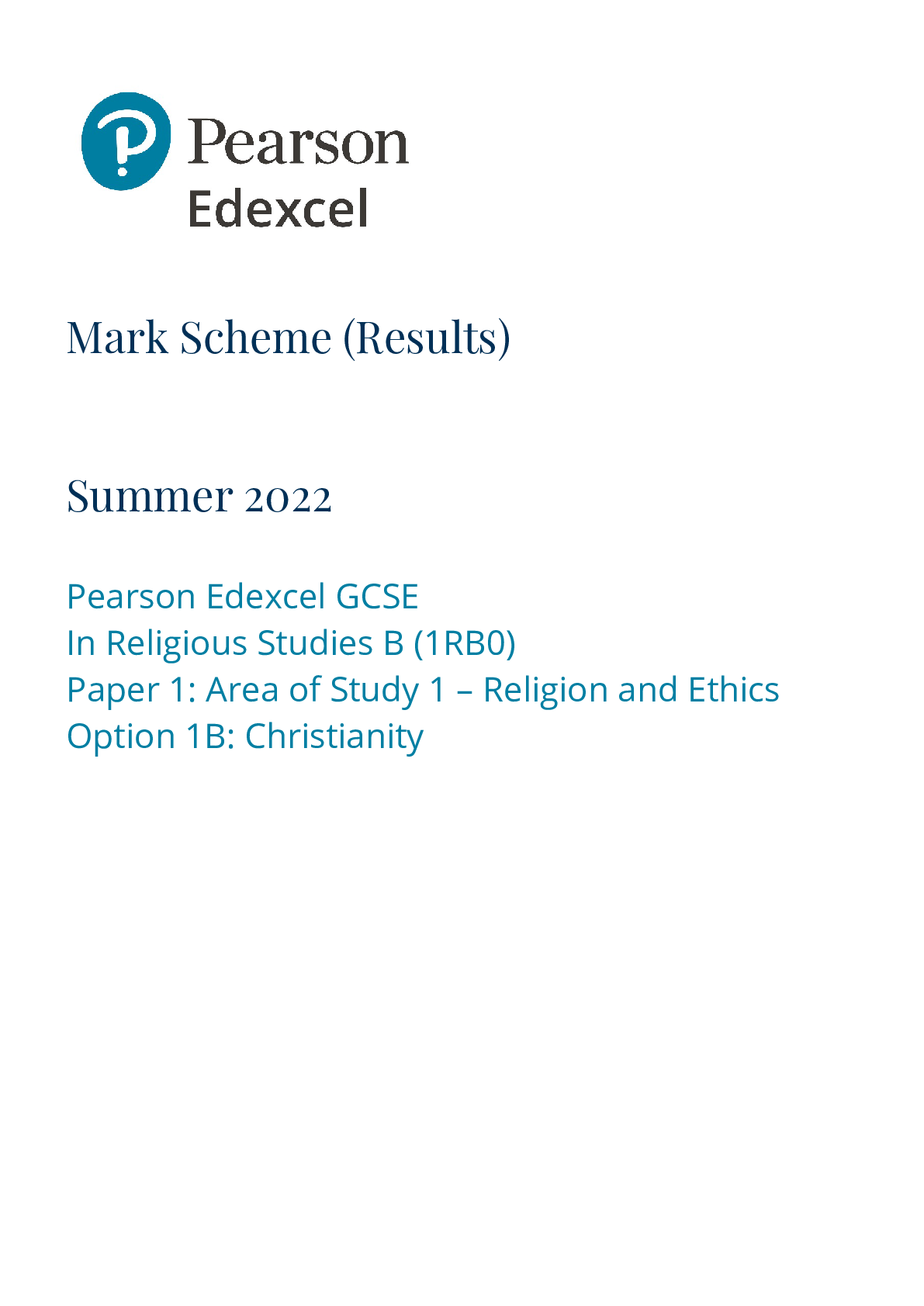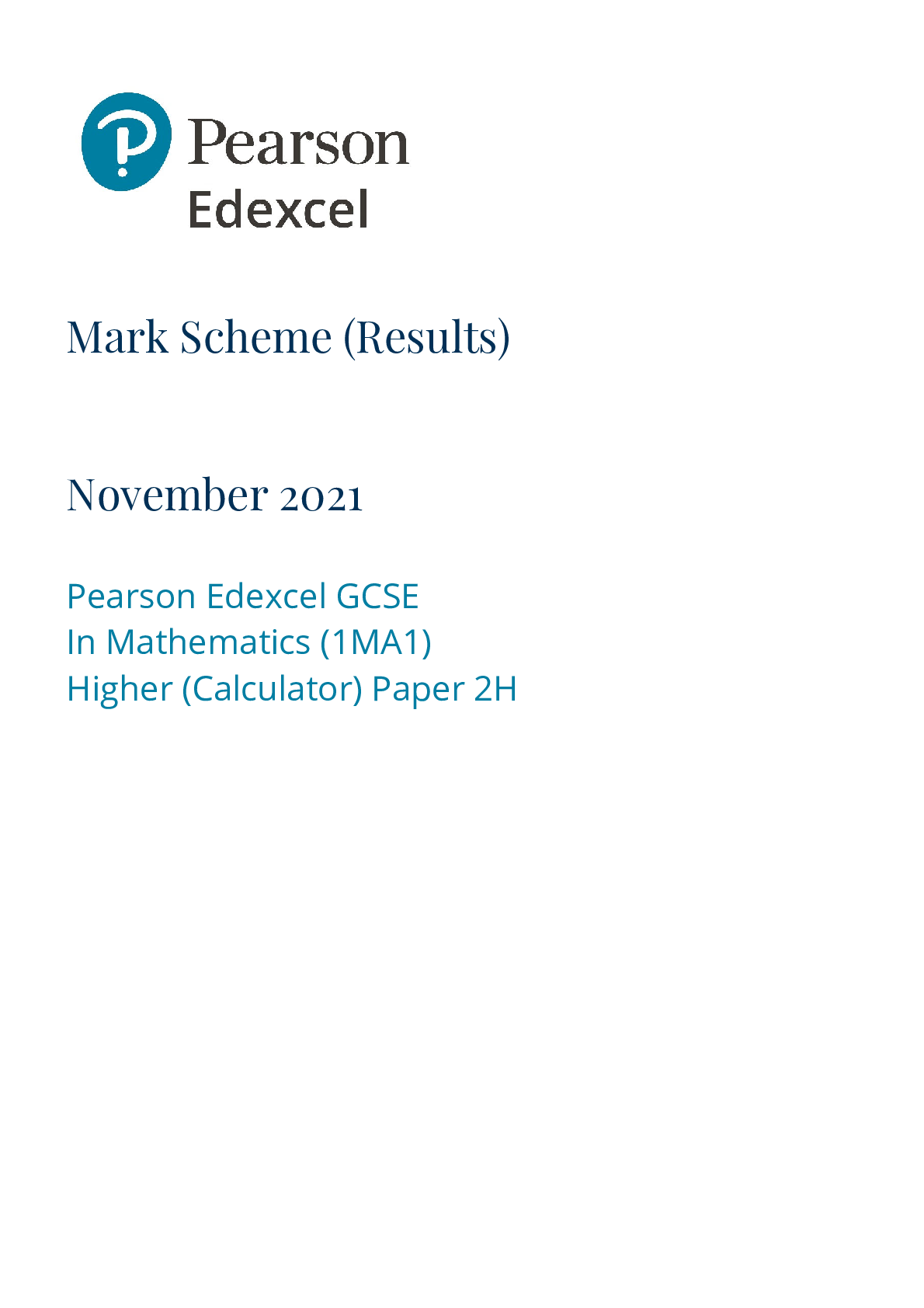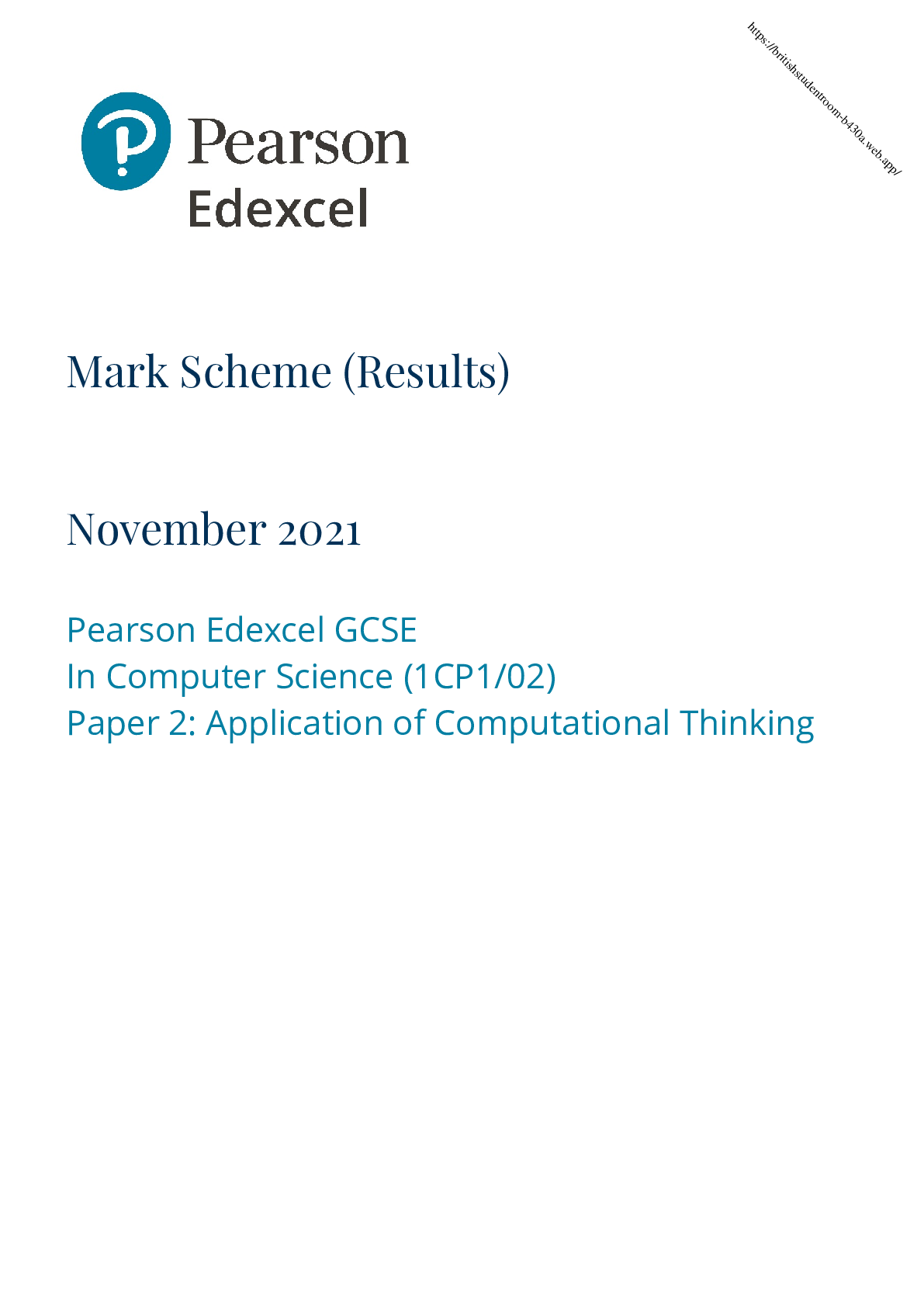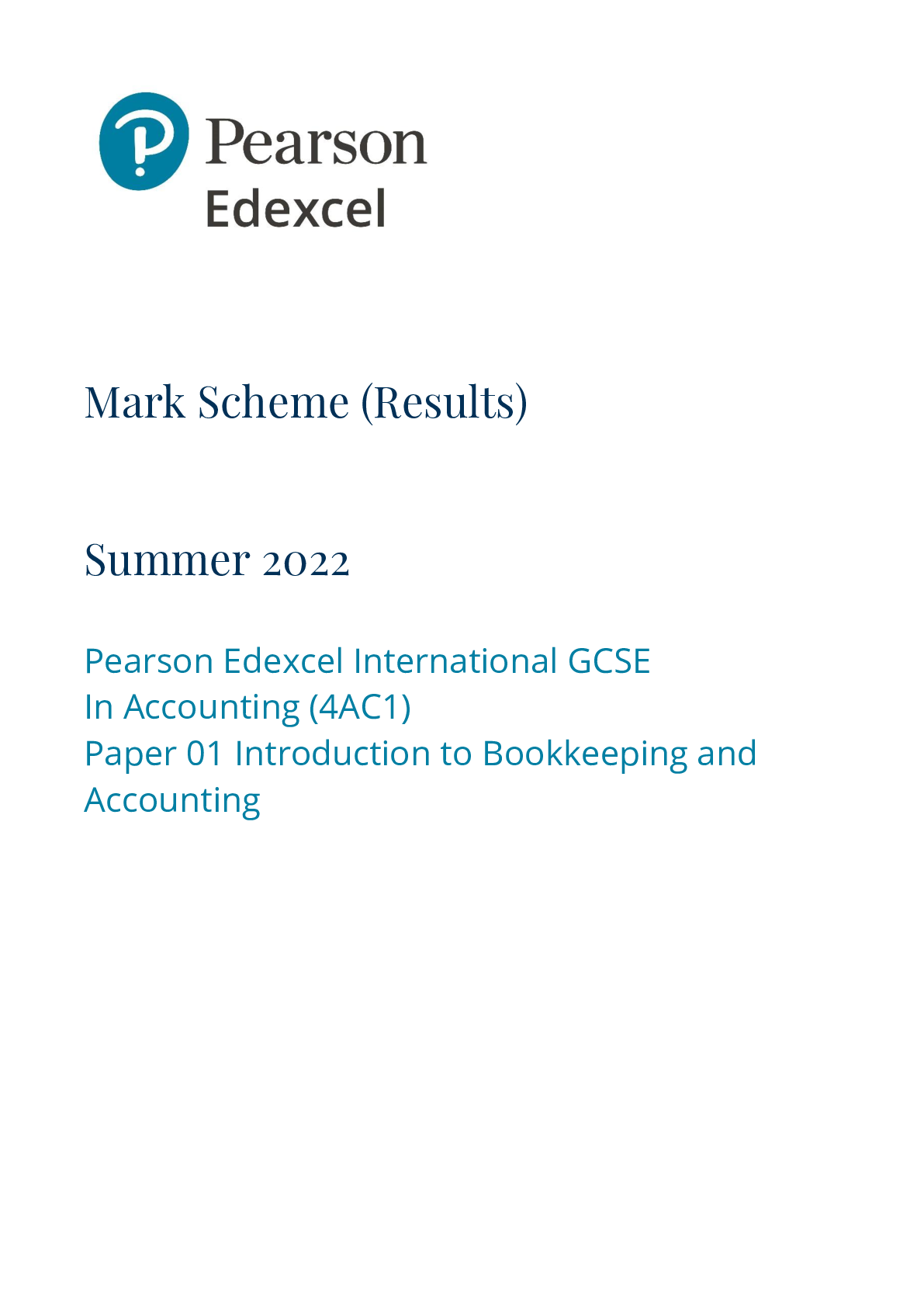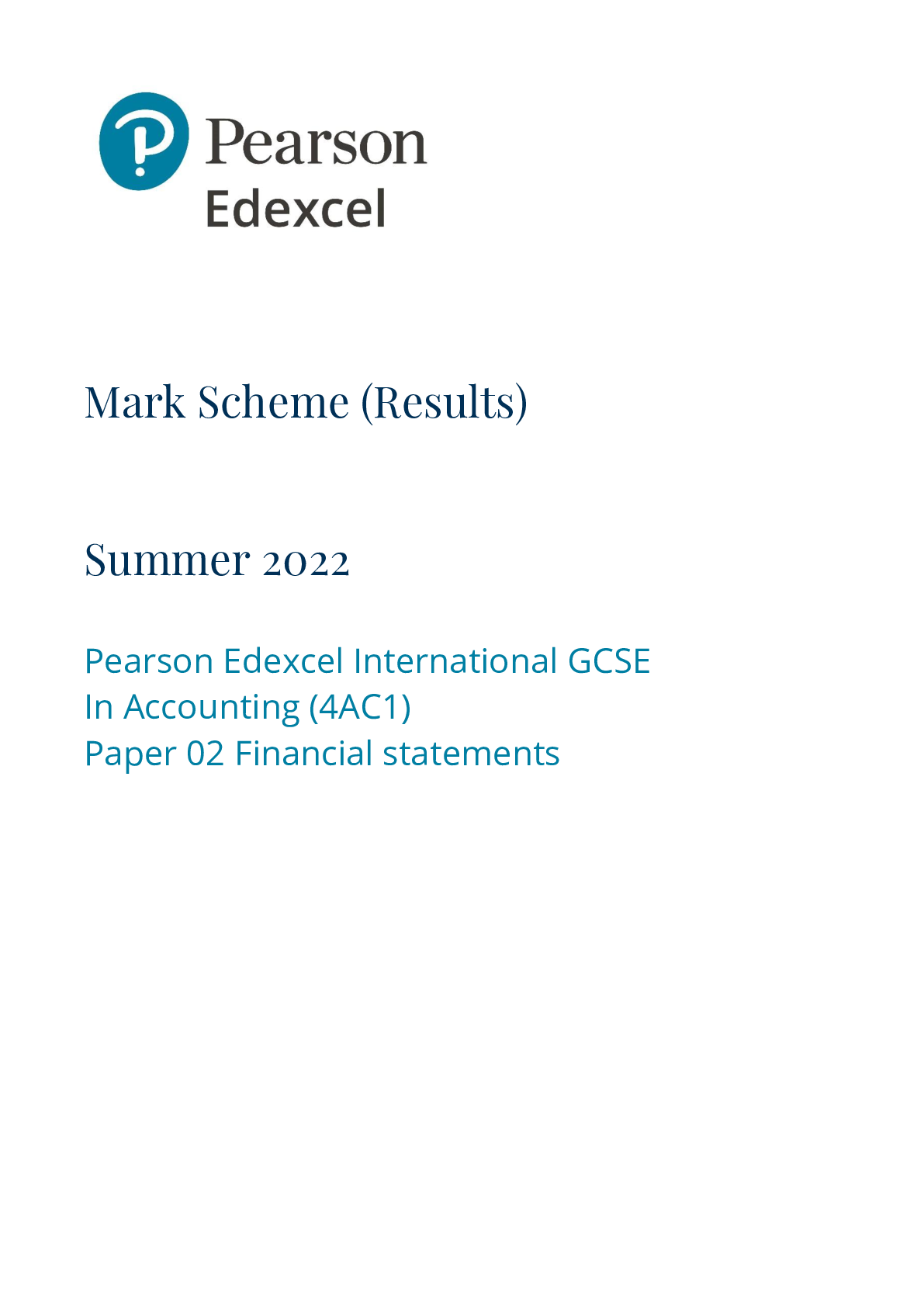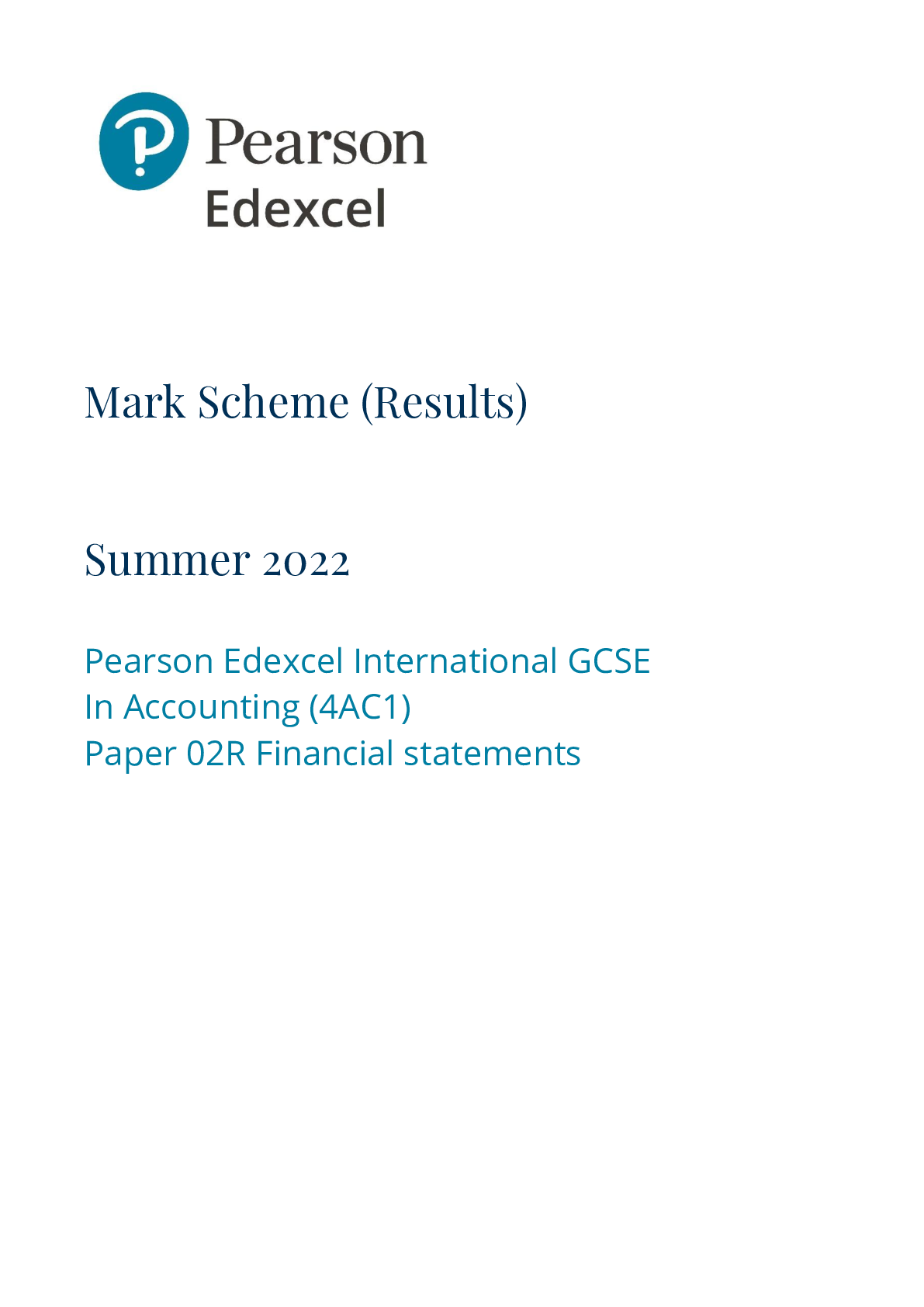Mathematics > MARK SCHEME > Mark Scheme (Results) Summer 2022 Pearson Edexcel GCSE In Mathematics (1MA1) Foundation (Calculator) (All)
Mark Scheme (Results) Summer 2022 Pearson Edexcel GCSE In Mathematics (1MA1) Foundation (Calculator) Paper 2F Edexcel and BTEC Qualifications
Document Content and Description Below
Mark Scheme (Results) Summer 2022 Pearson Edexcel GCSE In Mathematics (1MA1) Foundation (Calculator) Paper 2F Edexcel and BTEC Qualifications Edexcel and BTEC qualifications are awarded by Pears... on, the UK’s largest awarding body. We provide a wide range of qualifications including academic, vocational, occupational and specific programmes for employers. For further information visit our qualifications websites at www.edexcel.com or www.btec.co.uk. Alternatively, you can get in touch with us using the details on our contact us page at www.edexcel.com/contactus. Pearson: helping people progress, everywhere Pearson aspires to be the world’s leading learning company. Our aim is to help everyone progress in their lives through education. We believe in every kind of learning, for all kinds of people, wherever they are in the world. We’ve been involved in education for over 150 years, and by working across 70 countries, in 100 languages, we have built an international reputation for our commitment to high standards and raising achievement through innovation in education. Find out more about how we can help you and your students at: www.pearson.com/uk Summer 2022 Question Paper Log Number P66304A Publications Code 1MA1_2F_2206_MS All the material in this publication is copyright © Pearson Education Ltd 2022 General marking guidance These notes offer general guidance, but the specific notes for examiners appertaining to individual questions take precedence. 1 All candidates must receive the same treatment. Examiners must mark the last candidate in exactly the same way as they mark the first. Where some judgement is required, mark schemes will provide the principles by which marks will be awarded; exemplification/indicative content will not be exhaustive. When examiners are in doubt regarding the application of the mark scheme to a candidate’s response, the response should be sent to review. 2 All the marks on the mark scheme are designed to be awarded; mark schemes should be applied positively. Examiners should also be prepared to award zero marks if the candidate’s response is not worthy of credit according to the mark scheme. If there is a wrong answer (or no answer) indicated on the answer line always check the working in the body of the script (and on any diagrams), and award any marks appropriate from the mark scheme. Questions where working is not required: In general, the correct answer should be given full marks. Questions that specifically require working: In general, candidates who do not show working on this type of question will get no marks – full details will be given in the mark scheme for each individual question. 3 Crossed out work This should be marked unless the candidate has replaced it with an alternative response. 4 Choice of method If there is a choice of methods shown, mark the method that leads to the answer given on the answer line. If no answer appears on the answer line, mark both methods then award the lower number of marks. 5 Incorrect method If it is clear from the working that the “correct” answer has been obtained from incorrect working, award 0 marks. Send the response to review for your Team Leader to check. 6 Follow through marks Follow through marks which involve a single stage calculation can be awarded without working as you can check the answer, but if ambiguous do not award. Follow through marks which involve more than one stage of calculation can only be awarded on sight of the relevant working, even if it appears obvious that there is only one way you could get the answer given. 7 Ignoring subsequent work It is appropriate to ignore subsequent work when the additional work does not change the answer in a way that is inappropriate for the question or its context. (eg an incorrectly cancelled fraction when the unsimplified fraction would gain full marks). It is not appropriate to ignore subsequent work when the additional work essentially makes the answer incorrect (eg. incorrect algebraic simplification). 8 Probability Probability answers must be given as a fraction, percentage or decimal. If a candidate gives a decimal equivalent to a probability, this should be written to at least 2 decimal places (unless tenths). Incorrect notation should lose the accuracy marks, but be awarded any implied method marks. If a probability fraction is given then cancelled incorrectly, ignore the incorrectly cancelled answer. 9 Linear equations Unless indicated otherwise in the mark scheme, full marks can be gained if the solution alone is given on the answer line, or otherwise unambiguously identified in working (without contradiction elsewhere). Where the correct solution only is shown substituted, but not identified as the solution, the accuracy mark is lost but any method marks can be awarded (embedded answers). 10 Range of answers Unless otherwise stated, when an answer is given as a range (eg 3.5 – 4.2) then this is inclusive of the end points (eg 3.5, 4.2) and all numbers within the range 11 Number in brackets after a calculation Where there is a number in brackets after a calculation eg 2 × 6 (=12) then the mark can be awarded either for the correct method, implied by the calculation or for the correct answer to the calculation. 12 Use of inverted commas Some numbers in the mark scheme will appear inside inverted commas eg “12” × 50 ; the number in inverted commas cannot be any number – it must come from a correct method or process but the candidate may make an arithmetic error in their working. 13 Word in square brackets Where a word is used in square brackets eg [area] × 1.5 : the value used for [area] does not have to come from a correct method or process but is the value that the candidate believes is the area. If there are any constraints on the value that can be used, details will be given in the mark scheme. 14 Misread If a candidate misreads a number from the question. eg uses 252 instead of 255; method or process marks may be awarded provided the question has not been simplified. Examiners should send any instance of a suspected misread to review. Guidance on the use of abbreviations within this mark scheme M method mark awarded for a correct method or partial method P process mark awarded for a correct process as part of a problem solving question A accuracy mark (awarded after a correct method or process; if no method or process is seen then full marks for the question are implied but see individual mark schemes for more details) C communication mark awarded for a fully correct statement(s) with no contradiction or ambiguity B unconditional accuracy mark (no method needed) oe or equivalent cao correct answer only ft follow through (when appropriate as per mark scheme) sc special case dep dependent (on a previous mark) indep independent awrt answer which rounds to isw ignore subsequent working Paper: 1MA1/2F Question Answer Mark Mark scheme Additional guidance 1 1480 B1 cao 2 7 10 B1 oe fraction 3 3 B1 cao 4 Suitable number eg 725 B1 for a suitable 3 digit number ending in 0 or 5 5 40 B1 cao 6 −11, −7, −2, 3, 8, 10 B1 for −11, −7, −2, 3, 8, 10 Accept reverse order 7 (a) Hexagon B1 accept irregular hexagon Accept unambiguous misspellings (b) AF B1 cao Accept FA (c) AB or EF B1 AB or EF. Accept BA or FE or both 8 (a) 3, 2 B1 cao (b) Point at (−4, 3) B1 cao (c) Circle drawn, centre (1, −1) B2 fully correct diagram Allow reasonable hand-drawn attempts (B1 circle drawn with radius 4 cm (any centre) or circle drawn using centre (1, −1) r ≠ 4 cm) Paper: 1MA1/2F Question Answer Mark Mark scheme Additional guidance 9 (a) 23 B1 cao (b) 10 : 56 M1 for 10 or 56 identified 56 : 10 implies this mark only A1 for 10 : 56 or any other equivalent ratio Accept 1 : 5.6 10 213 P1 for beginning to work with costs eg 1428 – 150 (= 1278) or 1428 ÷ 6 (= 238) and 150 ÷ 6 (= 25) P1 for complete process to find monthly payment eg “1278” ÷ 6 or “238” – “25” A1 cao 11 39 with reasoning M1 for a method to find angle ACB eg 180 – 116 − 25 A1 for 39 ACB = 39 or x = 39 or C = 39 or just 39 is acceptable for this accuracy mark C1 for x = 39 with reasoning eg Angles in a triangle add up to 180 and Vertically opposite angles are equal or Vertically opposite angles are equal or Angles on a straight line add up to 180 OR The exterior angle of a triangle is equal to the sum of the interior opposite angles and Angles on a straight line add up to 180 Angle may be shown on diagram if no ambiguity or contradiction The key words underlined must be present. There should be no incorrect reasons given. All reasons given should be used, not just a list of angle facts. Paper: 1MA1/2F Question Answer Mark Mark scheme Additional guidance 12 (a) 9 B1 cao (b) 6 M1 starts to find input using inverse operations eg 154 ÷ 11 (= 14) or indicates ÷ 11 and − 8 or derivation of equation eg (8+ n) × 11 = 154 or starting to solve for unknown eg 154 − 8 × 11 (= 66) ÷11 and −8 could be seen in a flow diagram Evidence could be provided by algebraic statement, numerical statements or by diagram A1 cao 13 53 19 67 139 17 26 16 59 70 45 83 198 B3 for a fully correct table (B2 for at least 7 figures correctly placed) (B1 for the 4, 5 or 6 values correctly placed) 14 (i) > B1 cao (ii) = B1 cao 15 (a) 774 M1 for at least three of 0 × 3 (= 0) or 1 × 57 (= 57) or 2 × 84 (= 168) or 3 × 75 (= 225) or 4 × 81 (= 324) or for 0 × 3 + 1 × 57 + 2 × 84 + 3 × 75 + 4 × 81 Note if 2 non zero products are seen award M1 Use of the figure 777 is enough for M1 A1 cao (b) 3 M1 for method to begin to work with the median, eg 300 ÷ 2 (= 150) Accept 301 in place of 300 A1 cao NB mean = 2.58 Paper: 1MA1/2F Question Answer Mark Mark scheme Additional guidance 16 47 P1 for process to find scale factor eg 62 ÷ 12.4 (= 5) or 12.4 ÷ 62 (= 0.2) or 9.4 ÷ 12.4 (= 0.758...) or 12.4 ÷ 9.4 ( = 1.31..) Note 1:500 is an acceptable scale factor Accept working in mixed units or with inconsistent units eg 620 ÷ 12.4 (= 50) for process marks only P1 for process to use the scale factor eg “5” × 9.4 or 9.4 ÷ “0.2” or 62 × “0.758..” or 62 ÷ “1.31..” A1 Accept answers in the range 46.5 to 47.7 17 Line Drawn B3 for a correct line between x = –2 and x = 4 Accept freehand line drawn (B2 for a correct straight-line segment through at least 3 of (–2, 6), (–1, 5), (0, 4), (1, 3), (2, 2), (3, 1), (4, 0) or for all of these points plotted but not joined or for a line drawn with a negative gradient through (0, 4) and clear intention to use a gradient of −1, eg a line through (0, 4) going across 1 square and down 1 square) Ignore any incorrect points Table of values x –2 –1 0 1 2 3 4 y 6 5 4 3 2 1 0 (B1 for at least 2 correct points stated or plotted or a line drawn with negative gradient through (0, 4) or a line with gradient −1) Ignore any incorrect points Coordinates may be in a table or working Do not accept y = 4 drawn Paper: 1MA1/2F Question Answer Mark Mark scheme Additional guidance 18 13.2 P1 process to convert decimal time, eg 25.3 × 60 (= 1518) or 0.3 × 60 (= 18) OR process to work with mean, eg [time] ÷ 115 (= 0.22) or 1÷ (115 ÷ [time]) (= 0.22) [time] could be 25.3 or any other time that has been incorrectly changed from 25.3 hours P1 full process to work out mean time allocated for appointment, eg “1518” ÷ 115 or “0.22” × 60 A1 cao 19 1.19 P1 process to find number of small bags that can be filled, eg [3kg] ÷ 150 (= 20) oe [3kg] must be 3 and zeros only eg 300 Build up methods are allowed to imply process P1 for starting a process to work with percentage for cost of box, eg 17.60 × 35 100 (= 6.16) or 100 + 35 (= 135) works with starting cost per small bag, 17.60 ÷ “20” Cost per small bag given as £0.88 will imply P1P1 P1 for full process to work with percentage increase, eg 17.60 × "135" 100 (= 23.76) begins process to work with percentage for a small bag, eg “0.88” × 35 100 (= 0.308) P1 full process to find selling price for small bag, eg “23.76” ÷ “20” (= 1.188) full process to find selling price for small bag, “0.88” × 135 100 (= 1.188) oe A1 cao Paper: 1MA1/2F Question Answer Mark Mark scheme Additional guidance 20 (a) 0.87, 0.94, 0.94 B2 for all probabilities correct Accept any equivalent fraction, eg 87 47 , 100 50 or equivalent percentage form 87%, 94% (B1 for 0.87 or 0.94 correctly placed) (b) 0.0078 M1 for 0.13 × 0.06 oe A1 0.0078 oe Accept any equivalent fraction, eg 39 5000 or equivalent percentage form 0.78% or 7.8 × 10-3 21 (a) x 15 B1 cao (b) 40 – 10x M1 for method to expand one bracket or collect like terms, eg 4 × x + 4 × 3 (= 4x + 12) or 7 × 4 − 7 × 2x (= 28 – 14x) or 4 × x− 7 × 2x (= 4x– 14x) and 4 × 3 + 7 × 4 (= 12 + 28) A1 oe (c) 3x 2 (5x + y) M1 for 3(5x 3 + x 2 y) or x(15x 2 + 3xy) or 3x(5x 2 + xy) or x 2 (15x + 3y) or 3x 2 (ax + by) Where a ≥ 1 and b ≥ 1 [Show More]
Last updated: 1 year ago
Preview 1 out of 21 pages
Instant download
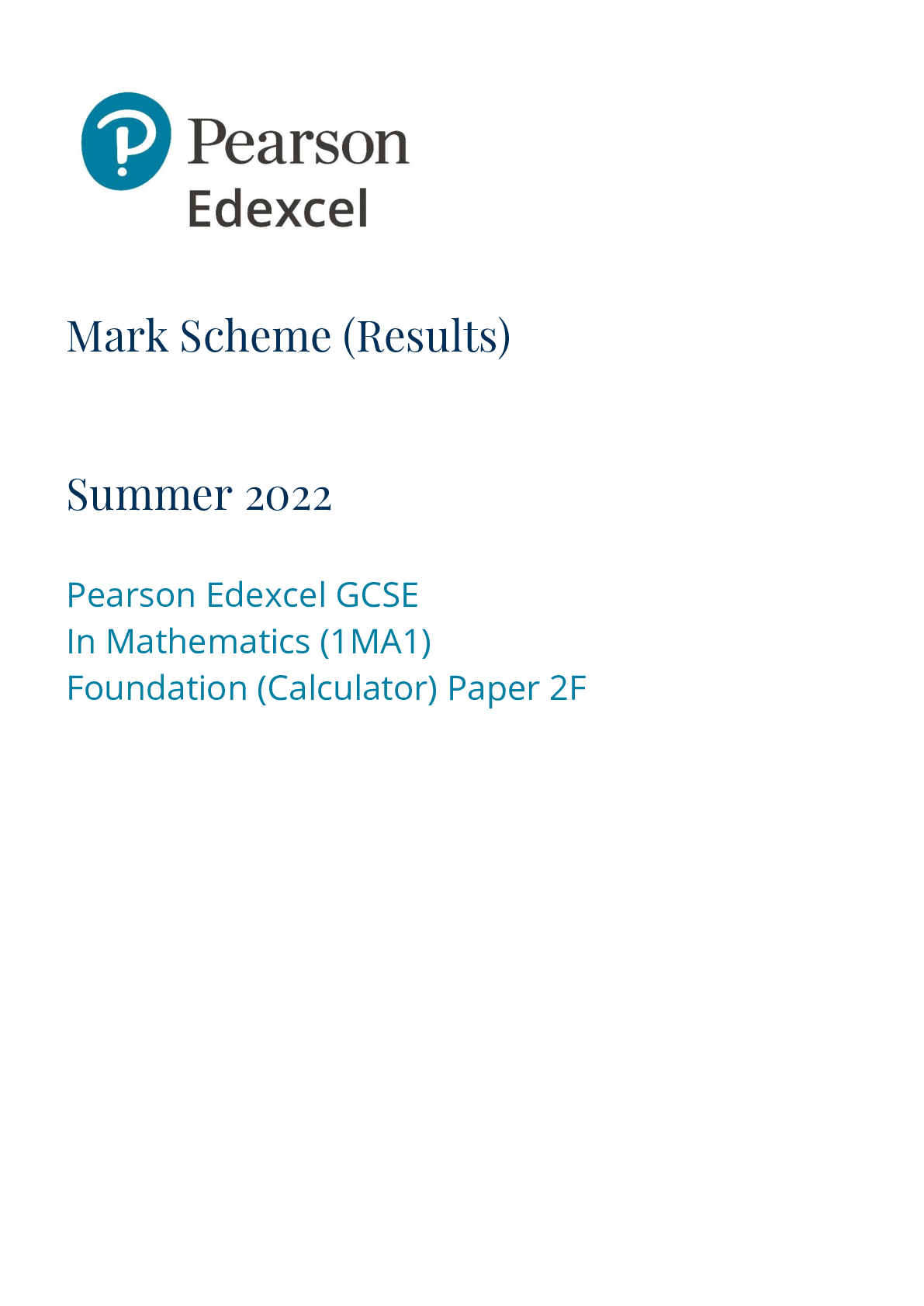
Buy this document to get the full access instantly
Instant Download Access after purchase
Add to cartInstant download
Reviews( 0 )
Document information
Connected school, study & course
About the document
Uploaded On
Apr 04, 2023
Number of pages
21
Written in
Additional information
This document has been written for:
Uploaded
Apr 04, 2023
Downloads
0
Views
83

